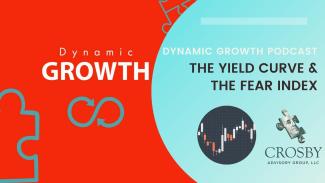
Inverted Yield Curves & The Fear Index
Yield Curve and The VIX
The inverted yield curve has predicted a recession 22 times since 1900. Today we’ll break down the key indicators used to measure market volatility, including the yield curve and the VIX index.
A yield curve plots Treasury bonds at 3, 6, and 12 months, as well as 2, 5, 10, and 30 years. When the yield curve inverts, often a recession will follow in the next 6-24 months. Historically you expect that longer duration bonds will pay more than shorter ones – money today is worth more than in the future – so if the yield curve inverts it’s an indicator that a recession may be on the horizon.
The inverted yield curve has predicted every recession since 1955, and in fact, it has inverted 28 times since 1900, and 22 of those times a recession has followed. However, keep in mind that while it has predicted every recession, it has also given multiple false warnings. From our point of view, as long as publicly-traded company earnings continue to be solid, we’ll maintain our position in the market.
So what? Well, as of April 1, 2022, the yield curve has some inversions. The 5 & 10 years have inverted, the 5 & 30 years, as well as the 2 & 10 years. This is the first time we’ve seen this since 2019. Does this mean a recession is coming? Maybe yes, maybe no.
Now let’s look at the VIX – also known as the Fear Index. The VIX provides a real-time market index to measure volatility for the next 30 days. A number is assigned by using a complex mathematical formula and if that number is under 20 then it predicts a period of low volatility, while over 20 forecasts an increased level of volatility. As of April 1, 2022, the VIX is at 19.53.
What does all this mean? Investors can and should use these market indicators to make educated decisions about their investments. Some investors – called contrarians – will buy when the VIX is above 20 and sell/hold when it’s below 20. The average investor might use the VIX to decide when to enter the market with new investments. If you are risk-averse and the VIX is low you may want to put more money in at a faster rate or alternatively if the VIX is high maybe you act slower.
At Crosby Advisory we research and watch these indicators literally every day. Over time, we have moved many of our portfolio durations to 5 years and under – that way we are less impacted by interest rate increases. If you are investing on your own, always be sure to do your homework! Remember there is a fine line between reactive and not reactive enough.
In the podcast we referenced two resources :
- Investopedia: https://www.investopedia.com/
- Ray Dalio on diversification https://www.youtube.com/watch?v=Nu4lHaSh7D4
Please note: This content is not a direct recommendation for investment. Investing involves risk including the potential loss of principal. Not all investments are suitable for all people. Crosby Advisory Group, LLC is a registered investment advisor in Ohio, Florida, and Texas.

